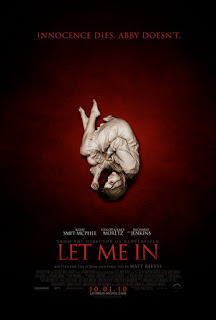Let Me In
 I found the most interesting thing about the DVD of Let Me In on the supplemental materials. The director, Matt Reeves, spoke of how he was moved by the original novel in Swedish, Let the Right One In, by John Ajvide Lindqvist. Reeves said the book reminded him of his own childhood (sans vampires) and that Lindqvist was excited to have Reeves direct, since he loved Cloverfield.
I found the most interesting thing about the DVD of Let Me In on the supplemental materials. The director, Matt Reeves, spoke of how he was moved by the original novel in Swedish, Let the Right One In, by John Ajvide Lindqvist. Reeves said the book reminded him of his own childhood (sans vampires) and that Lindqvist was excited to have Reeves direct, since he loved Cloverfield.No where in this seventeen-minutes Behind the Scenes was a mention of Tomas Alfredson, who happened to make the first movie based on the novel. The existence of the movie was completely glossed over. I wouldn't mind so much, except that Reeves has essentially made a shot-by-shot remake of that Swedish film.
Why do such a thing? Well, I guess it's for the people in the English-speaking world who don't want to read subtitles. Reeves really adds nothing to the story, except to Americanize it he embosses the story with a layer of the American zeal for religion. An early scene has Ronald Reagan (it's set in 1983) quote de Tocqueville about the passion in America's churches, and the young boy's mother is a Jesus freak. Of course, this stuff wouldn't play in secular Sweden.
Who is the boy? Well, he's a twelve-year old, Owen, and he's the kind of kid who's always playing by himself and getting picked on. He has a dark streak, and is attracted to knives. When a father and daughter move in next door, he makes friends with the girl, Abby, even though she says they can't be friends. She's never seen in daylight, and goes barefoot even in the snow.
It becomes clear soon that she is a vampire, and that her father (Richard Jenkins) is a caretaker who goes out and kills people to get their blood. The relationship between the two is much more spelled out in the American version, which makes the ending much less ambiguous.
As I said in my review of Let the Right One In, this is a film about the despair of adolescence. Romeo and Juliet is used as a theme, but Abby's sexuality is, befitting an American film, not touched upon (the Swedish film gives a shot of her absence of sexual parts, which the American film only hints at). Abby becomes Owen's protector, and his bullies get their just desserts in a climax in a swimming pool, that is shot exactly the way Alfredson shot it.
Watching this film was different than watching most films, because it soon became clear that nothing was going to be different about it (I have faint memory of a scene with cats in the Swedish film that is missing here). Otherwise, every plot point is the same, and scenes are framed in exactly the same manner. It appears Reeves storyboarded using the original.
That isn't a crime, or a terrible thing. This film isn't any worse than the original. It's atmospheric, and the children (Kodi Smit-McPhee and Chloe Grace Moretz) are fine, though not quite as startling as the Swedish cast.
The only reason this film was made was to try to cash in, as will the upcoming Stieg Larsson adaptations. I have a feeling, though, that David Fincher won't cop out and make a shot-by-shot remake.


Comments
Post a Comment